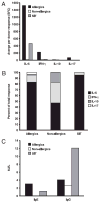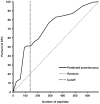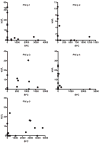Molecular determinants of T cell epitope recognition to the common Timothy grass allergen
- PMID: 20554959
- PMCID: PMC3310373
- DOI: 10.4049/jimmunol.1000405
Molecular determinants of T cell epitope recognition to the common Timothy grass allergen
Abstract
We investigated the molecular determinants of allergen-derived T cell epitopes in humans utilizing the Phleum pratense (Timothy grass) allergens (Phl p). PBMCs from allergic individuals were tested in ELISPOT assays with overlapping peptides spanning known Phl p allergens. A total of 43 distinct antigenic regions were recognized, illustrating the large breadth of grass-specific T cell epitopes. Th2 cytokines (as represented by IL-5) were predominant, whereas IFN-gamma, IL-10, and IL-17 were detected less frequently. Responses from specific immunotherapy treatment individuals were weaker and less consistent, yet similar in epitope specificity and cytokine pattern to allergic donors, whereas nonallergic individuals were essentially nonreactive. Despite the large breadth of recognition, nine dominant antigenic regions were defined, each recognized by multiple donors, accounting for 51% of the total response. Multiple HLA molecules and loci restricted the dominant regions, and the immunodominant epitopes could be predicted using bioinformatic algorithms specific for 23 common HLA-DR, DP, and DQ molecules. Immunodominance was also apparent at the Phl p Ag level. It was found that 52, 19, and 14% of the total response was directed to Phl p 5, 1, and 3, respectively. Interestingly, little or no correlation between Phl p-specific IgE levels and T cell responses was found. Thus, certain intrinsic features of the allergen protein might influence immunogenicity at the level of T cell reactivity. Consistent with this notion, different Phl p Ags were associated with distinct patterns of IL-5, IFN-gamma, IL-10, and IL-17 production.
Figures







Similar articles
-
T-cell epitopes of Phl p 1, major pollen allergen of timothy grass (Phleum pratense): evidence for crossreacting and non-crossreacting T-cell epitopes within grass group I allergens.J Allergy Clin Immunol. 1995 Dec;96(6 Pt 1):986-96. doi: 10.1016/s0091-6749(95)70237-7. J Allergy Clin Immunol. 1995. PMID: 8543758
-
Identification of isoform-specific T-cell epitopes in the major timothy grass pollen allergen, Phl p 5.Clin Exp Allergy. 1999 Dec;29(12):1614-25. doi: 10.1046/j.1365-2222.1999.00652.x. Clin Exp Allergy. 1999. PMID: 10594537
-
Grass-specific CD4(+) T-cells exhibit varying degrees of cross-reactivity, implications for allergen-specific immunotherapy.Clin Exp Allergy. 2014 Jul;44(7):986-98. doi: 10.1111/cea.12324. Clin Exp Allergy. 2014. PMID: 24708411 Free PMC article.
-
New strategies for allergen T cell epitope identification: going beyond IgE.Int Arch Allergy Immunol. 2014;165(2):75-82. doi: 10.1159/000368406. Epub 2014 Nov 15. Int Arch Allergy Immunol. 2014. PMID: 25402674 Free PMC article. Review.
-
The identification of potentially pathogenic and therapeutic epitopes from common human allergens.Ann Allergy Asthma Immunol. 2013 Jan;110(1):7-10. doi: 10.1016/j.anai.2012.10.015. Epub 2012 Nov 15. Ann Allergy Asthma Immunol. 2013. PMID: 23244651 Free PMC article. Review.
Cited by
-
Definition of a pool of epitopes that recapitulates the T cell reactivity against major house dust mite allergens.Clin Exp Allergy. 2015 Oct;45(10):1601-12. doi: 10.1111/cea.12507. Clin Exp Allergy. 2015. PMID: 25652035 Free PMC article.
-
T cell responses to known allergen proteins are differently polarized and account for a variable fraction of total response to allergen extracts.J Immunol. 2012 Aug 15;189(4):1800-11. doi: 10.4049/jimmunol.1200850. Epub 2012 Jul 11. J Immunol. 2012. PMID: 22786768 Free PMC article.
-
Ara h 1 CD4+ T cell epitope-based peptides: candidates for a peanut allergy therapeutic.Clin Exp Allergy. 2013 Jun;43(6):684-97. doi: 10.1111/cea.12113. Clin Exp Allergy. 2013. PMID: 23711131 Free PMC article.
-
Mesothelin-Targeted Recombinant Immunotoxins for Solid Tumors.Biomolecules. 2020 Jun 28;10(7):973. doi: 10.3390/biom10070973. Biomolecules. 2020. PMID: 32605175 Free PMC article. Review.
-
Urinary Peptides As a Novel Source of T Cell Allergen Epitopes.Front Immunol. 2018 Apr 26;9:886. doi: 10.3389/fimmu.2018.00886. eCollection 2018. Front Immunol. 2018. PMID: 29755469 Free PMC article.
References
-
- Romagnani S. Regulation of the development of type 2 T-helper cells in allergy. Curr Opin Immunol. 1994;6:838–846. - PubMed
-
- Mosmann TR, Coffman RL. TH1 and TH2 cells: different patterns of lymphokine secretion lead to different functional properties. Annu Rev Immunol. 1989;7:145–173. - PubMed
-
- Kapsenberg ML, Wierenga EA, Bos JD, Jansen HM. Functional subsets of allergen-reactive human CD4+ T cells. Immunol Today. 1991;12:392–395. - PubMed
-
- Romagnani S, Del Prete G, Maggi E, Parronchi P, Tiri A, Macchia D, Giudizi MG, Almerigogna F, Ricci M. Role of interleukins in induction and regulation of human IgE synthesis. Clin Immunol Immunopathol. 1989;50:S13–S23. - PubMed
-
- Del Prete GF, De Carli M, D’Elios MM, Maestrelli P, Ricci M, Fabbri L, Romagnani S. Allergen exposure induces the activation of allergen-specific Th2 cells in the airway mucosa of patients with allergic respiratory disorders. Eur J Immunol. 1993;23:1445–1449. - PubMed
Publication types
MeSH terms
Substances
Grants and funding
LinkOut - more resources
Full Text Sources
Other Literature Sources
Molecular Biology Databases
Research Materials

